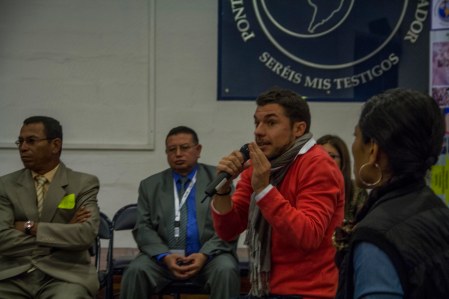During the official United Nations Habitat III conference and within the PUCE HIII official program, our PUCE-NTUA team organized in the auditorium of FADA/PUCE on October 20, “Weaving Chamanga – A Post-Disaster, Multi-Actor Design Process”.
The goal of this event was to underline the importance of coordinating post-disaster work, highlighting as an example, specifically the case study we worked with, the community of San José de Chamanga. The event was organized in the form of a participatory workshop, where all actors involved with Chamanga, such as representatives of the Ministry of Urban Development and Housing (MIDUVI), independent architects, institutions, universities, as well as community members and representatives were invited to participate. The basic goal was to make each actor aware of the type and qualities of work going on by others, and to foster better coordination. The event was open and drew about 150 participants.

The space was arranged in a circle, so as to allow for an efficient and egalitarian interaction among all people participating. Α large scale map of Chamanga was placed on the floor, in the middle of the circle. The whole process was organized in a methodology which was meant to allow for people to become aware of all the others in a short period of time, and to encourage maximum interactions and a brainstorming of ideas. This took place in three parts:
First part: all participating actors had 2’ minutes to describe their experience in Chamanga during or after the earthquake, their involvement and the biggest challenges they had been experiencing since then. In this way, instead of watching a series of monotonous and typical presentations, the story of Chamanga was being weaved by its own inhabitants and the actors involved in the reconstruction process, thus having the chance to become familiar with each other and with what had happened so far.
Second part: Each actor was responsible of presenting to the people passing by his table, the proposed project, offering people the opportunity to “visit” the proposals forming part of Chamanga’s masterplan. Our table presented by the model being used during the participatory workshop that took place on September 4. representing the outcome of these deliberations with the community, as well as a big banner where all process and the results were being described.
Third part: held again in the circular arrangement, five chairs in the middle were for those who wanted to participate on a challenging conversation referring to challenges, problems, and wishes and planning of next steps. Each time a chair was empty for those of the audience who wanted to take an active part in the conversation by answering, commenting, opposing or opening a new thread of discussion.




The event had a total duration of 3,5 hours creating a great opportunity for all to get better informed about the overall process regarding Chamanga, about the political intentions but also other actors involved, as well as next and previous steps. At the same time the first layer of coordination among those involved was created and certain streamlining based on real needs took place.

